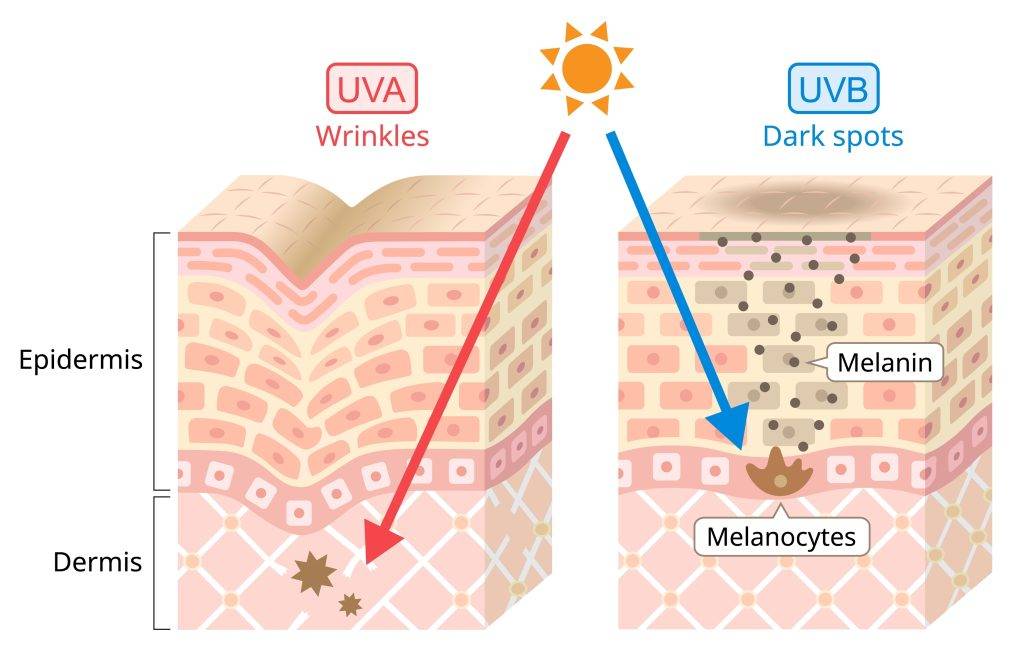Scientists have developed a cutting-edge cooling sunscreen that not only blocks UV rays but also keeps skin cooler in scorching heat, offering dual protection for hot summer days.
Picture this: a scorching summer day, the sun beats down relentlessly, and your skin feels like it’s simmering under the heat. While traditional sunscreens shield against harmful UV rays, they do nothing to counteract the sweltering discomfort of overheating.
Now, researchers have developed a revolutionary cooling sunscreen that not only protects against UV damage but also lowers skin temperature by up to 6 °C.
P.S: Find the answers to all your skincare questions on our dedicated Skin Health HQ.
Why You Need Sunscreen for UV and Heat Protection
Sunscreen plays a vital role in safeguarding skin against the harmful effects of ultraviolet (UV) radiation. UV radiation is divided into three types: UVA, UVB, and UVC.
While UVC rays are mostly absorbed by the Earth’s atmosphere, UVA and UVB rays penetrate the skin and cause significant damage.
How UV Rays Damage Your Skin

UVA rays reach deep into the skin, breaking down collagen and elastin fibres. This accelerates ageing and contributes to wrinkles and sagging.
They also indirectly damage DNA by generating reactive oxygen species, which increase the risk of skin cancer. UVB rays primarily target the outer skin layers, causing sunburn and direct DNA damage. These mutations can lead to skin cancers such as melanoma. UVB also elicits an increase in melanin production in the skin, causing dark spots and pigmentation.
Prolonged exposure to UV rays without protection can cause immediate effects like sunburn and long-term conditions such as hyperpigmentation, photoageing, and heightened risk of skin cancer.
The World Health Organisation estimates that excessive UV exposure causes over 1.5 million skin cancer cases and 120,000 deaths annually.
Sunscreens mitigate these risks by either absorbing or reflecting UV radiation. Chemical sunscreens absorb UV radiation and convert it into heat. Mineral sunscreens, with ingredients reflect UV rays away from the skin.
Both types are effective against UV damage, but neither tackles the heat build-up that comes with sun exposure.
This absorbed heat can lead to discomfort, heat rash, and dehydration. Overheated skin can also experience impaired barrier function, increasing susceptibility to irritation.
Watch now: How to Stay Healthy During a Heatwave with Dr Mark Yap
The Researchers Behind the Innovation
The revolutionary cooling sunscreen is the result of cutting-edge work by a team led by Rufan Zhang, a materials scientist known for his expertise in nanotechnology and heat management.
Zhang and his colleagues conducted the research at Tsinghua University, a globally renowned institution in Beijing, China. Their findings were recently published in the journal Nano Letters, a leading peer-reviewed platform for nanoscience research.
Recognising the potential to enhance sunscreen, the researchers adapted their technology to create a formula that addresses both UV damage and heat absorption.
Their breakthrough not only enhances sun protection but also offers a practical solution to the discomfort of overheating in the sun.
This collaboration between material science and cosmetic innovation highlights the potential of interdisciplinary research to tackle everyday problems in novel ways.
How Cooling Sunscreen Works
The secret behind the cooling sunscreen lies in its carefully engineered ingredients and innovative application of radiative cooling technology. The researchers designed the sunscreen by combining six components: titanium dioxide (TiO₂) nanoparticles, water, ethanol, a silicone polymer called polydimethylsiloxane, pigments, and a moisturising cream. Each ingredient plays a specific role in achieving dual protection.
Titanium dioxide, already a common ingredient in mineral sunscreens, is the key to the cooling effect. By adjusting the size of the TiO₂ nanoparticles, the team enabled them to reflect not only harmful UV light but also heat-generating infrared radiation. This dual action reduces heat build-up on the skin, keeping it cooler in intense sunlight.

Image credit: Adapted from Nano Letters 2024, DOI: 10.1021/acs.nanolett.4c04969
The formula was rigorously tested to ensure it performed as both a sunscreen and a cooling agent. It provides SPF 50 protection, water resistance, and retains its efficacy after 12 hours of simulated sunlight exposure under a xenon lamp.
By reflecting solar heat away from the skin, this sunscreen achieves a significant cooling effect, reducing skin temperature by up to 6 °C compared to bare skin.
Why Cooling Sunscreen Could Transform Sun Protection
As global temperatures continue to rise, the need for sun protection that addresses both UV radiation and heat has never been greater. Traditional sunscreens effectively block harmful UV rays but fail to tackle the discomfort and risks associated with overheating.
This new cooling sunscreen bridges that gap, offering a practical solution for those who spend extended periods in the sun.
Affordability adds to its appeal. The prototype costs just $0.92 per 10 grams, comparable to existing commercial sunscreens.
With its low production cost, it holds potential for widespread adoption, making advanced sun protection accessible to more people.
Beyond individual use, this innovation may inspire broader applications in industries like sports, outdoor workwear, and even skincare for sensitive individuals who struggle with heat-related skin conditions.

